Professional IT Culture: Navigating Ethical Dilemmas in AI Development
VerifiedAdded on 2020/02/24
|12
|2908
|90
Report
AI Summary
This report addresses the ethical dilemma faced by an AI consultant, John, working for an electric car company. The company is pushing for a test drive of a self-driving car before the AI components are fully remodeled, leading to a conflict between John's professional ethics and the company's desire to compete in the market. The report explores the ethical responses to this dilemma, considering the consequences, consistent application of principles, and the importance of caring for the customer's safety. It also references the ACS Code of Professional Conduct and suggests ways for John to resolve the ethical conflict, emphasizing the primacy of public interest and the need for honesty and professional development. The report concludes that prioritizing customer safety and adhering to ethical guidelines are crucial, even if it means delaying the product launch to ensure thorough testing and remodeling of the AI components.
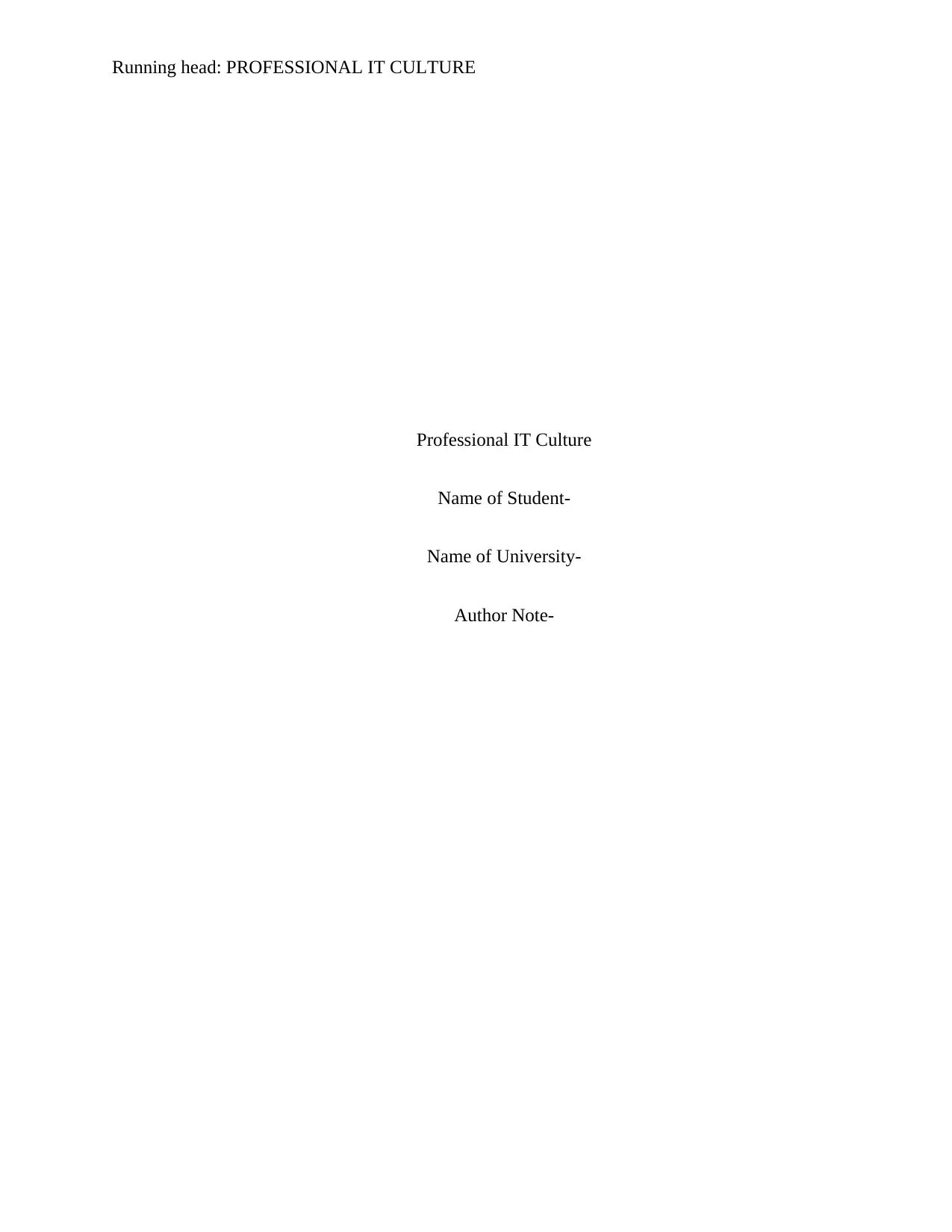
Running head: PROFESSIONAL IT CULTURE
Professional IT Culture
Name of Student-
Name of University-
Author Note-
Professional IT Culture
Name of Student-
Name of University-
Author Note-
Paraphrase This Document
Need a fresh take? Get an instant paraphrase of this document with our AI Paraphraser
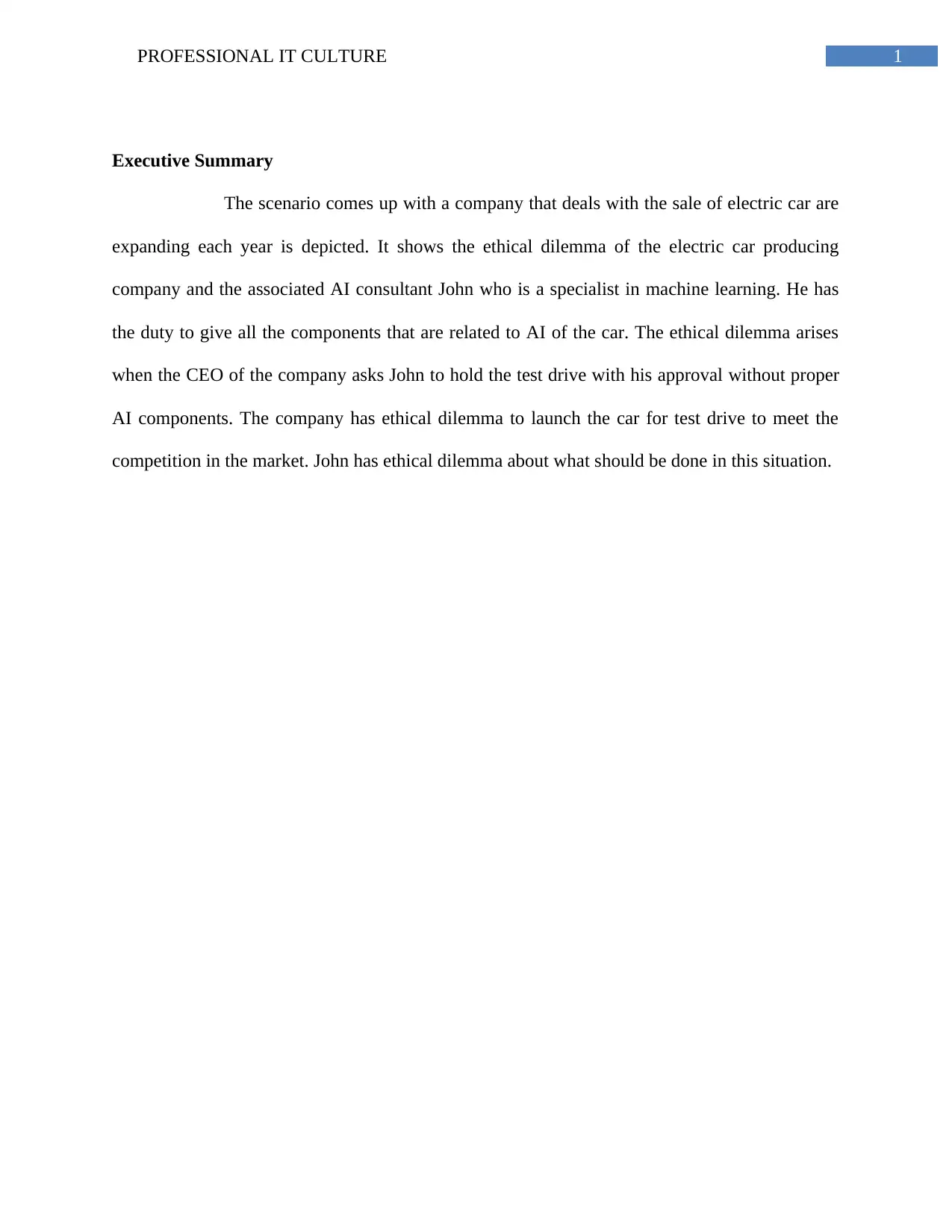
1PROFESSIONAL IT CULTURE
Executive Summary
The scenario comes up with a company that deals with the sale of electric car are
expanding each year is depicted. It shows the ethical dilemma of the electric car producing
company and the associated AI consultant John who is a specialist in machine learning. He has
the duty to give all the components that are related to AI of the car. The ethical dilemma arises
when the CEO of the company asks John to hold the test drive with his approval without proper
AI components. The company has ethical dilemma to launch the car for test drive to meet the
competition in the market. John has ethical dilemma about what should be done in this situation.
Executive Summary
The scenario comes up with a company that deals with the sale of electric car are
expanding each year is depicted. It shows the ethical dilemma of the electric car producing
company and the associated AI consultant John who is a specialist in machine learning. He has
the duty to give all the components that are related to AI of the car. The ethical dilemma arises
when the CEO of the company asks John to hold the test drive with his approval without proper
AI components. The company has ethical dilemma to launch the car for test drive to meet the
competition in the market. John has ethical dilemma about what should be done in this situation.
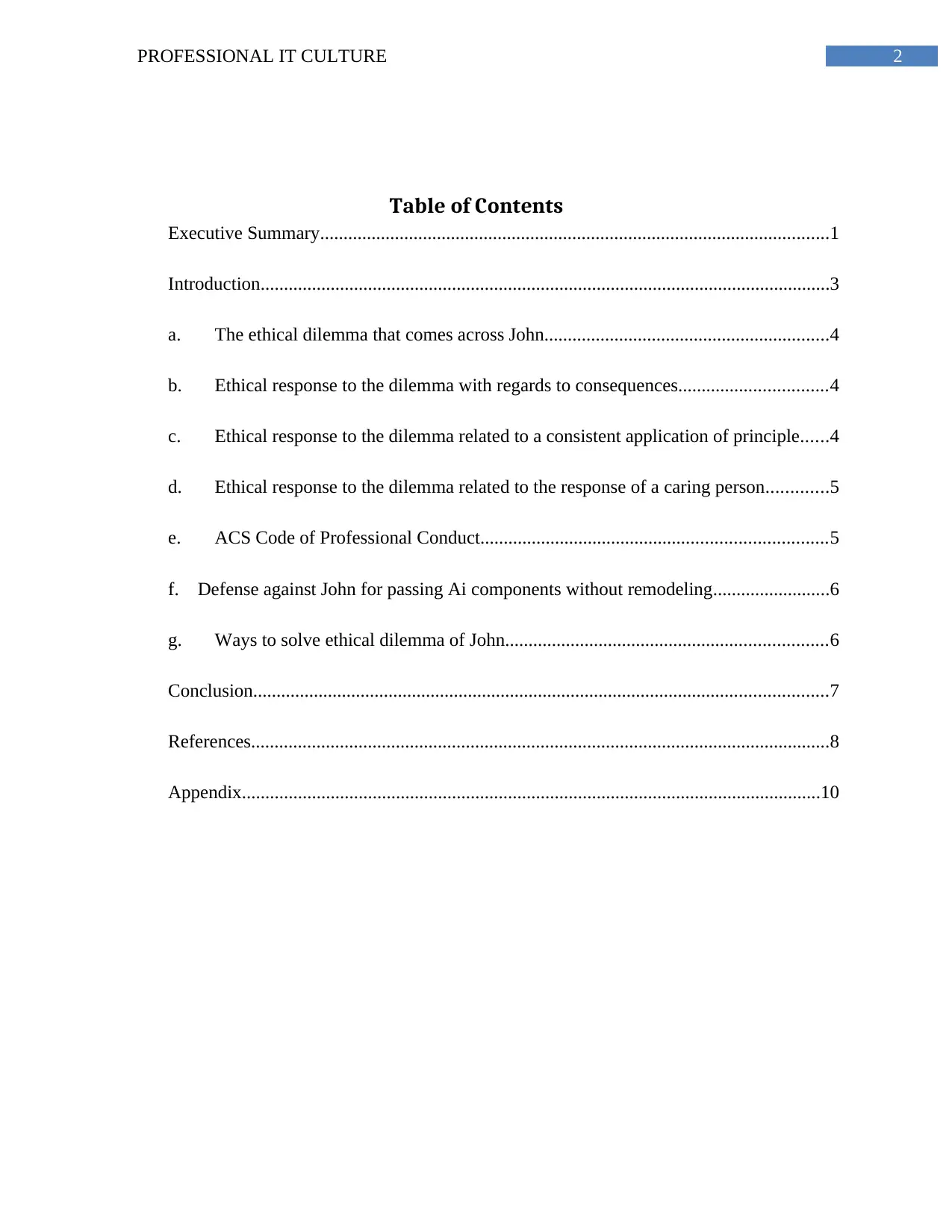
2PROFESSIONAL IT CULTURE
Table of Contents
Executive Summary.............................................................................................................1
Introduction..........................................................................................................................3
a. The ethical dilemma that comes across John.............................................................4
b. Ethical response to the dilemma with regards to consequences................................4
c. Ethical response to the dilemma related to a consistent application of principle......4
d. Ethical response to the dilemma related to the response of a caring person.............5
e. ACS Code of Professional Conduct..........................................................................5
f. Defense against John for passing Ai components without remodeling.........................6
g. Ways to solve ethical dilemma of John.....................................................................6
Conclusion...........................................................................................................................7
References............................................................................................................................8
Appendix............................................................................................................................10
Table of Contents
Executive Summary.............................................................................................................1
Introduction..........................................................................................................................3
a. The ethical dilemma that comes across John.............................................................4
b. Ethical response to the dilemma with regards to consequences................................4
c. Ethical response to the dilemma related to a consistent application of principle......4
d. Ethical response to the dilemma related to the response of a caring person.............5
e. ACS Code of Professional Conduct..........................................................................5
f. Defense against John for passing Ai components without remodeling.........................6
g. Ways to solve ethical dilemma of John.....................................................................6
Conclusion...........................................................................................................................7
References............................................................................................................................8
Appendix............................................................................................................................10
⊘ This is a preview!⊘
Do you want full access?
Subscribe today to unlock all pages.

Trusted by 1+ million students worldwide
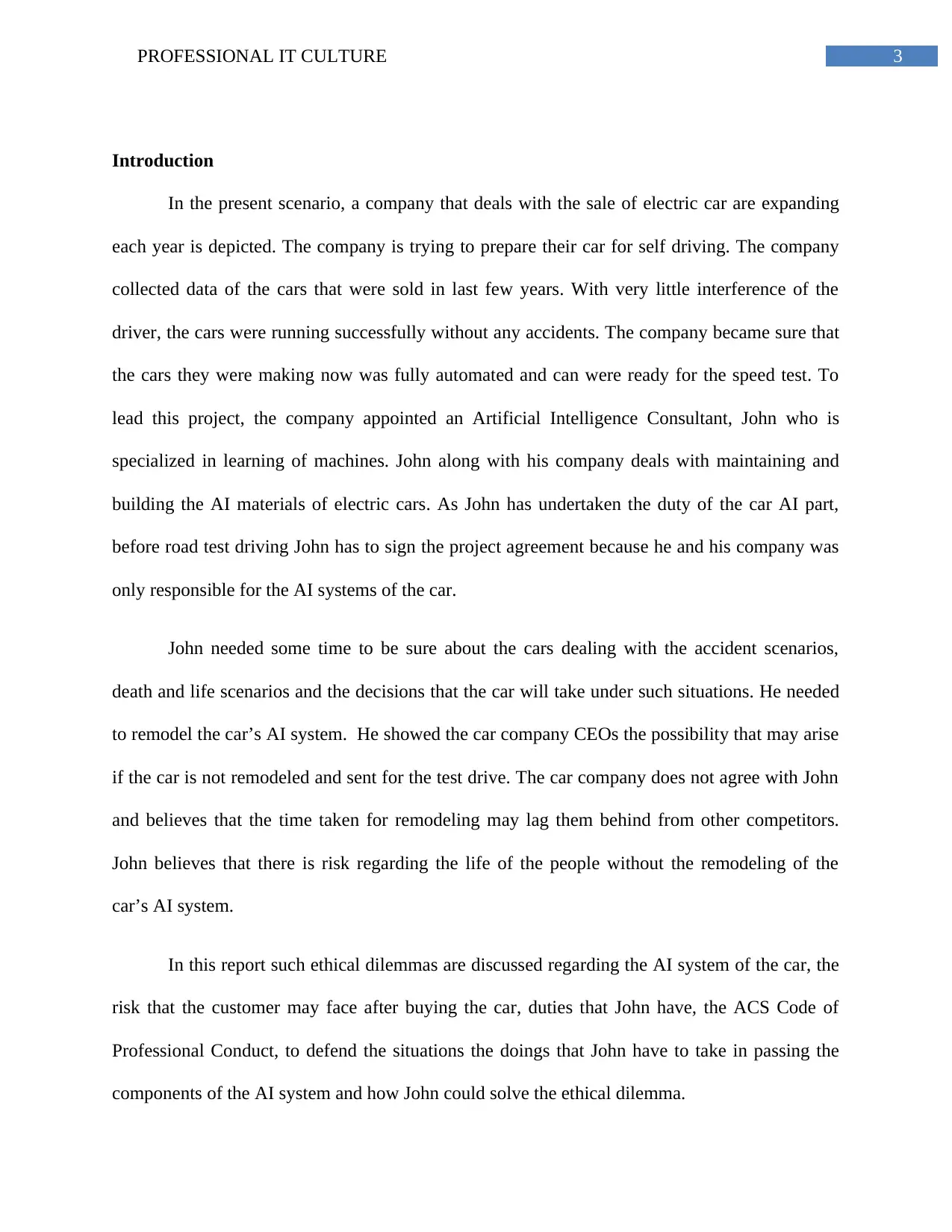
3PROFESSIONAL IT CULTURE
Introduction
In the present scenario, a company that deals with the sale of electric car are expanding
each year is depicted. The company is trying to prepare their car for self driving. The company
collected data of the cars that were sold in last few years. With very little interference of the
driver, the cars were running successfully without any accidents. The company became sure that
the cars they were making now was fully automated and can were ready for the speed test. To
lead this project, the company appointed an Artificial Intelligence Consultant, John who is
specialized in learning of machines. John along with his company deals with maintaining and
building the AI materials of electric cars. As John has undertaken the duty of the car AI part,
before road test driving John has to sign the project agreement because he and his company was
only responsible for the AI systems of the car.
John needed some time to be sure about the cars dealing with the accident scenarios,
death and life scenarios and the decisions that the car will take under such situations. He needed
to remodel the car’s AI system. He showed the car company CEOs the possibility that may arise
if the car is not remodeled and sent for the test drive. The car company does not agree with John
and believes that the time taken for remodeling may lag them behind from other competitors.
John believes that there is risk regarding the life of the people without the remodeling of the
car’s AI system.
In this report such ethical dilemmas are discussed regarding the AI system of the car, the
risk that the customer may face after buying the car, duties that John have, the ACS Code of
Professional Conduct, to defend the situations the doings that John have to take in passing the
components of the AI system and how John could solve the ethical dilemma.
Introduction
In the present scenario, a company that deals with the sale of electric car are expanding
each year is depicted. The company is trying to prepare their car for self driving. The company
collected data of the cars that were sold in last few years. With very little interference of the
driver, the cars were running successfully without any accidents. The company became sure that
the cars they were making now was fully automated and can were ready for the speed test. To
lead this project, the company appointed an Artificial Intelligence Consultant, John who is
specialized in learning of machines. John along with his company deals with maintaining and
building the AI materials of electric cars. As John has undertaken the duty of the car AI part,
before road test driving John has to sign the project agreement because he and his company was
only responsible for the AI systems of the car.
John needed some time to be sure about the cars dealing with the accident scenarios,
death and life scenarios and the decisions that the car will take under such situations. He needed
to remodel the car’s AI system. He showed the car company CEOs the possibility that may arise
if the car is not remodeled and sent for the test drive. The car company does not agree with John
and believes that the time taken for remodeling may lag them behind from other competitors.
John believes that there is risk regarding the life of the people without the remodeling of the
car’s AI system.
In this report such ethical dilemmas are discussed regarding the AI system of the car, the
risk that the customer may face after buying the car, duties that John have, the ACS Code of
Professional Conduct, to defend the situations the doings that John have to take in passing the
components of the AI system and how John could solve the ethical dilemma.
Paraphrase This Document
Need a fresh take? Get an instant paraphrase of this document with our AI Paraphraser
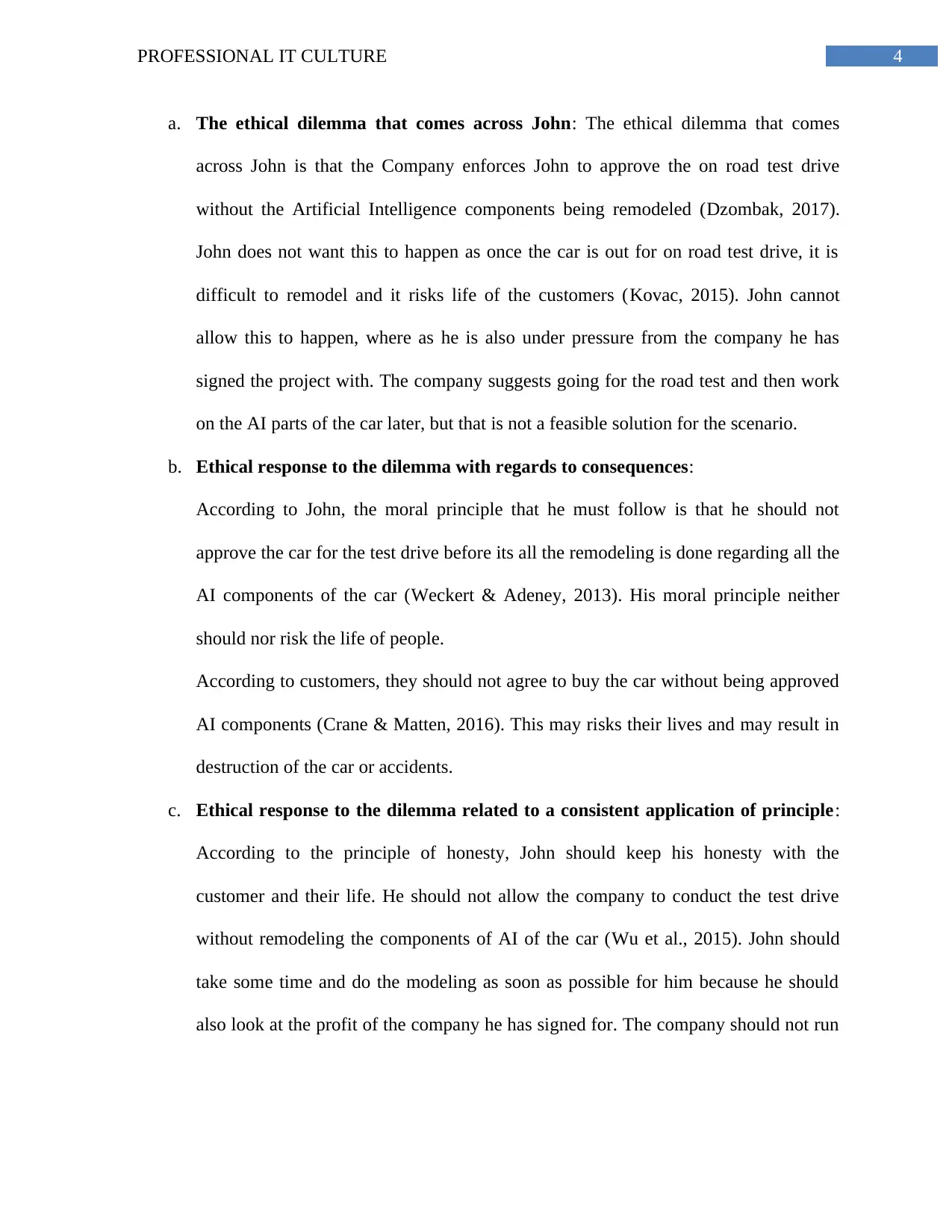
4PROFESSIONAL IT CULTURE
a. The ethical dilemma that comes across John: The ethical dilemma that comes
across John is that the Company enforces John to approve the on road test drive
without the Artificial Intelligence components being remodeled (Dzombak, 2017).
John does not want this to happen as once the car is out for on road test drive, it is
difficult to remodel and it risks life of the customers (Kovac, 2015). John cannot
allow this to happen, where as he is also under pressure from the company he has
signed the project with. The company suggests going for the road test and then work
on the AI parts of the car later, but that is not a feasible solution for the scenario.
b. Ethical response to the dilemma with regards to consequences:
According to John, the moral principle that he must follow is that he should not
approve the car for the test drive before its all the remodeling is done regarding all the
AI components of the car (Weckert & Adeney, 2013). His moral principle neither
should nor risk the life of people.
According to customers, they should not agree to buy the car without being approved
AI components (Crane & Matten, 2016). This may risks their lives and may result in
destruction of the car or accidents.
c. Ethical response to the dilemma related to a consistent application of principle:
According to the principle of honesty, John should keep his honesty with the
customer and their life. He should not allow the company to conduct the test drive
without remodeling the components of AI of the car (Wu et al., 2015). John should
take some time and do the modeling as soon as possible for him because he should
also look at the profit of the company he has signed for. The company should not run
a. The ethical dilemma that comes across John: The ethical dilemma that comes
across John is that the Company enforces John to approve the on road test drive
without the Artificial Intelligence components being remodeled (Dzombak, 2017).
John does not want this to happen as once the car is out for on road test drive, it is
difficult to remodel and it risks life of the customers (Kovac, 2015). John cannot
allow this to happen, where as he is also under pressure from the company he has
signed the project with. The company suggests going for the road test and then work
on the AI parts of the car later, but that is not a feasible solution for the scenario.
b. Ethical response to the dilemma with regards to consequences:
According to John, the moral principle that he must follow is that he should not
approve the car for the test drive before its all the remodeling is done regarding all the
AI components of the car (Weckert & Adeney, 2013). His moral principle neither
should nor risk the life of people.
According to customers, they should not agree to buy the car without being approved
AI components (Crane & Matten, 2016). This may risks their lives and may result in
destruction of the car or accidents.
c. Ethical response to the dilemma related to a consistent application of principle:
According to the principle of honesty, John should keep his honesty with the
customer and their life. He should not allow the company to conduct the test drive
without remodeling the components of AI of the car (Wu et al., 2015). John should
take some time and do the modeling as soon as possible for him because he should
also look at the profit of the company he has signed for. The company should not run

5PROFESSIONAL IT CULTURE
in loss. The modeling should be done by John and it should be done as soon as
possible.
d. Ethical response to the dilemma related to the response of a caring person: the
person who is buying the car should be taken care of. The life of the customer should
be at risk. To avoid that all the components of AI should be tested and remodeled
properly so that the customer’s lives are safe.
e. ACS Code of Professional Conduct, the requirement that are identified are as
follows:
Code 1 (refer to Appendix 1): According code of primacy of public interest, the
security of the customer should be kept in mind (Roberts, 2015). The car should not
be allowed for the test drive before all the components of AI are remodeled and tested
by the AI consultant.
Code 2 (refer to Appendix 2): According to Enhancement Quality, the AI
components of car should work properly. The car should run properly and there must
be no issues regarding the components of the car (Dalla Valle & Kenett, 2015). The
quality of the car should be kept high even if it takes some more time to launch the
car for test drive.
Code 3 (refer to Appendix 3): According to honesty Code of Professional Conduct, if
John agrees to launch the car without remodeling of the AI components, then he is
dishonest to the primacy of public interest that is stated in Code 1. He should be
honest with his work and not agree to launch the car for the test drive without being
completely tested.
in loss. The modeling should be done by John and it should be done as soon as
possible.
d. Ethical response to the dilemma related to the response of a caring person: the
person who is buying the car should be taken care of. The life of the customer should
be at risk. To avoid that all the components of AI should be tested and remodeled
properly so that the customer’s lives are safe.
e. ACS Code of Professional Conduct, the requirement that are identified are as
follows:
Code 1 (refer to Appendix 1): According code of primacy of public interest, the
security of the customer should be kept in mind (Roberts, 2015). The car should not
be allowed for the test drive before all the components of AI are remodeled and tested
by the AI consultant.
Code 2 (refer to Appendix 2): According to Enhancement Quality, the AI
components of car should work properly. The car should run properly and there must
be no issues regarding the components of the car (Dalla Valle & Kenett, 2015). The
quality of the car should be kept high even if it takes some more time to launch the
car for test drive.
Code 3 (refer to Appendix 3): According to honesty Code of Professional Conduct, if
John agrees to launch the car without remodeling of the AI components, then he is
dishonest to the primacy of public interest that is stated in Code 1. He should be
honest with his work and not agree to launch the car for the test drive without being
completely tested.
⊘ This is a preview!⊘
Do you want full access?
Subscribe today to unlock all pages.

Trusted by 1+ million students worldwide
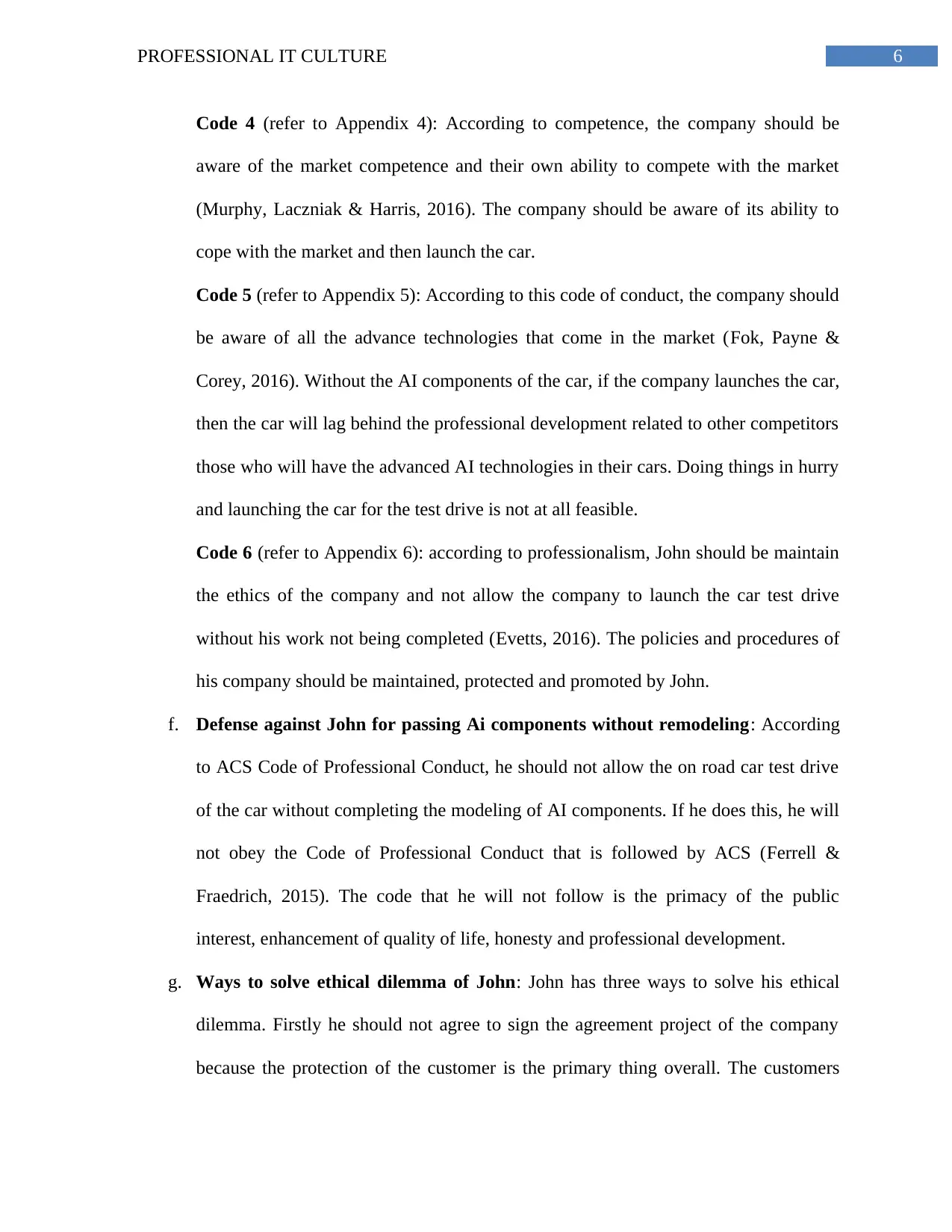
6PROFESSIONAL IT CULTURE
Code 4 (refer to Appendix 4): According to competence, the company should be
aware of the market competence and their own ability to compete with the market
(Murphy, Laczniak & Harris, 2016). The company should be aware of its ability to
cope with the market and then launch the car.
Code 5 (refer to Appendix 5): According to this code of conduct, the company should
be aware of all the advance technologies that come in the market (Fok, Payne &
Corey, 2016). Without the AI components of the car, if the company launches the car,
then the car will lag behind the professional development related to other competitors
those who will have the advanced AI technologies in their cars. Doing things in hurry
and launching the car for the test drive is not at all feasible.
Code 6 (refer to Appendix 6): according to professionalism, John should be maintain
the ethics of the company and not allow the company to launch the car test drive
without his work not being completed (Evetts, 2016). The policies and procedures of
his company should be maintained, protected and promoted by John.
f. Defense against John for passing Ai components without remodeling: According
to ACS Code of Professional Conduct, he should not allow the on road car test drive
of the car without completing the modeling of AI components. If he does this, he will
not obey the Code of Professional Conduct that is followed by ACS (Ferrell &
Fraedrich, 2015). The code that he will not follow is the primacy of the public
interest, enhancement of quality of life, honesty and professional development.
g. Ways to solve ethical dilemma of John: John has three ways to solve his ethical
dilemma. Firstly he should not agree to sign the agreement project of the company
because the protection of the customer is the primary thing overall. The customers
Code 4 (refer to Appendix 4): According to competence, the company should be
aware of the market competence and their own ability to compete with the market
(Murphy, Laczniak & Harris, 2016). The company should be aware of its ability to
cope with the market and then launch the car.
Code 5 (refer to Appendix 5): According to this code of conduct, the company should
be aware of all the advance technologies that come in the market (Fok, Payne &
Corey, 2016). Without the AI components of the car, if the company launches the car,
then the car will lag behind the professional development related to other competitors
those who will have the advanced AI technologies in their cars. Doing things in hurry
and launching the car for the test drive is not at all feasible.
Code 6 (refer to Appendix 6): according to professionalism, John should be maintain
the ethics of the company and not allow the company to launch the car test drive
without his work not being completed (Evetts, 2016). The policies and procedures of
his company should be maintained, protected and promoted by John.
f. Defense against John for passing Ai components without remodeling: According
to ACS Code of Professional Conduct, he should not allow the on road car test drive
of the car without completing the modeling of AI components. If he does this, he will
not obey the Code of Professional Conduct that is followed by ACS (Ferrell &
Fraedrich, 2015). The code that he will not follow is the primacy of the public
interest, enhancement of quality of life, honesty and professional development.
g. Ways to solve ethical dilemma of John: John has three ways to solve his ethical
dilemma. Firstly he should not agree to sign the agreement project of the company
because the protection of the customer is the primary thing overall. The customers
Paraphrase This Document
Need a fresh take? Get an instant paraphrase of this document with our AI Paraphraser
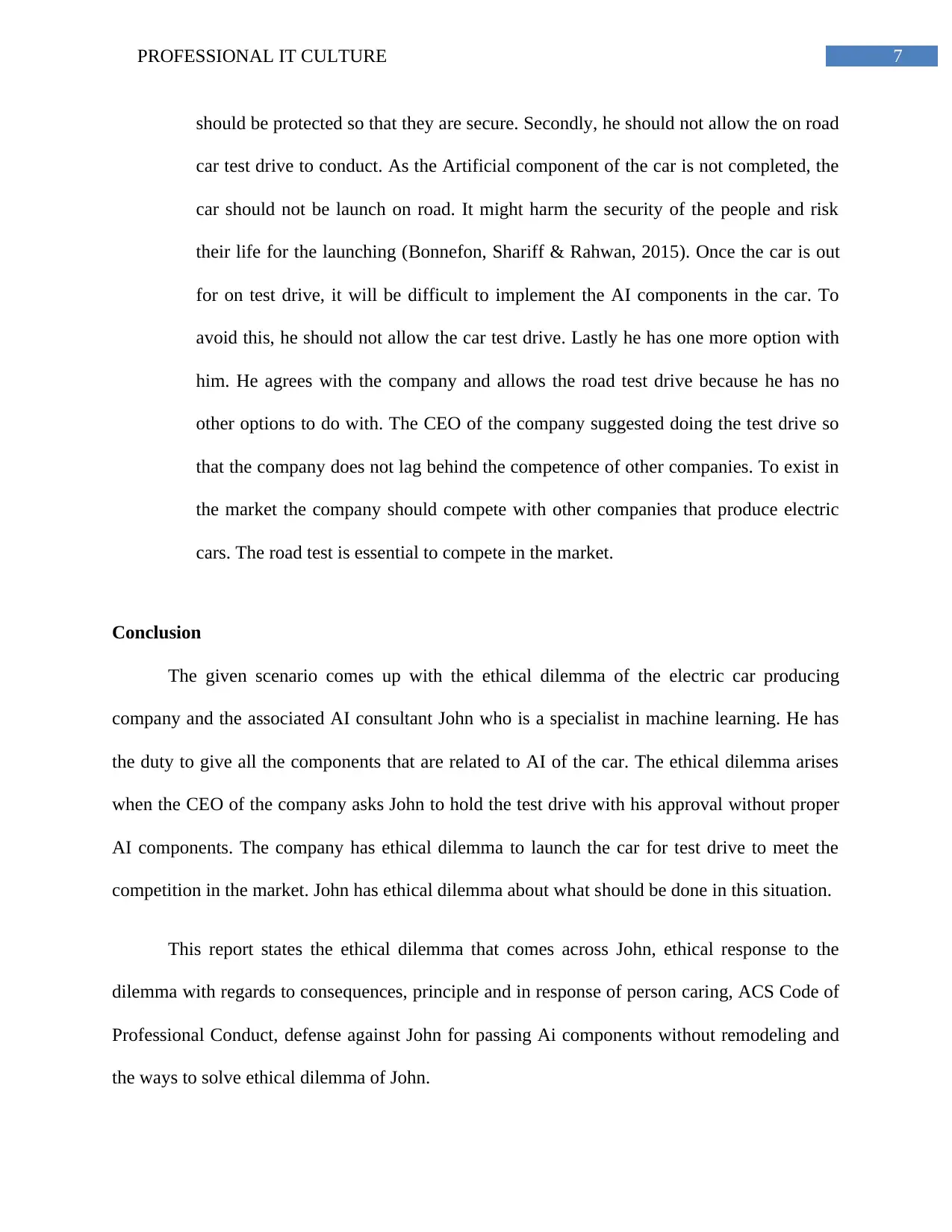
7PROFESSIONAL IT CULTURE
should be protected so that they are secure. Secondly, he should not allow the on road
car test drive to conduct. As the Artificial component of the car is not completed, the
car should not be launch on road. It might harm the security of the people and risk
their life for the launching (Bonnefon, Shariff & Rahwan, 2015). Once the car is out
for on test drive, it will be difficult to implement the AI components in the car. To
avoid this, he should not allow the car test drive. Lastly he has one more option with
him. He agrees with the company and allows the road test drive because he has no
other options to do with. The CEO of the company suggested doing the test drive so
that the company does not lag behind the competence of other companies. To exist in
the market the company should compete with other companies that produce electric
cars. The road test is essential to compete in the market.
Conclusion
The given scenario comes up with the ethical dilemma of the electric car producing
company and the associated AI consultant John who is a specialist in machine learning. He has
the duty to give all the components that are related to AI of the car. The ethical dilemma arises
when the CEO of the company asks John to hold the test drive with his approval without proper
AI components. The company has ethical dilemma to launch the car for test drive to meet the
competition in the market. John has ethical dilemma about what should be done in this situation.
This report states the ethical dilemma that comes across John, ethical response to the
dilemma with regards to consequences, principle and in response of person caring, ACS Code of
Professional Conduct, defense against John for passing Ai components without remodeling and
the ways to solve ethical dilemma of John.
should be protected so that they are secure. Secondly, he should not allow the on road
car test drive to conduct. As the Artificial component of the car is not completed, the
car should not be launch on road. It might harm the security of the people and risk
their life for the launching (Bonnefon, Shariff & Rahwan, 2015). Once the car is out
for on test drive, it will be difficult to implement the AI components in the car. To
avoid this, he should not allow the car test drive. Lastly he has one more option with
him. He agrees with the company and allows the road test drive because he has no
other options to do with. The CEO of the company suggested doing the test drive so
that the company does not lag behind the competence of other companies. To exist in
the market the company should compete with other companies that produce electric
cars. The road test is essential to compete in the market.
Conclusion
The given scenario comes up with the ethical dilemma of the electric car producing
company and the associated AI consultant John who is a specialist in machine learning. He has
the duty to give all the components that are related to AI of the car. The ethical dilemma arises
when the CEO of the company asks John to hold the test drive with his approval without proper
AI components. The company has ethical dilemma to launch the car for test drive to meet the
competition in the market. John has ethical dilemma about what should be done in this situation.
This report states the ethical dilemma that comes across John, ethical response to the
dilemma with regards to consequences, principle and in response of person caring, ACS Code of
Professional Conduct, defense against John for passing Ai components without remodeling and
the ways to solve ethical dilemma of John.
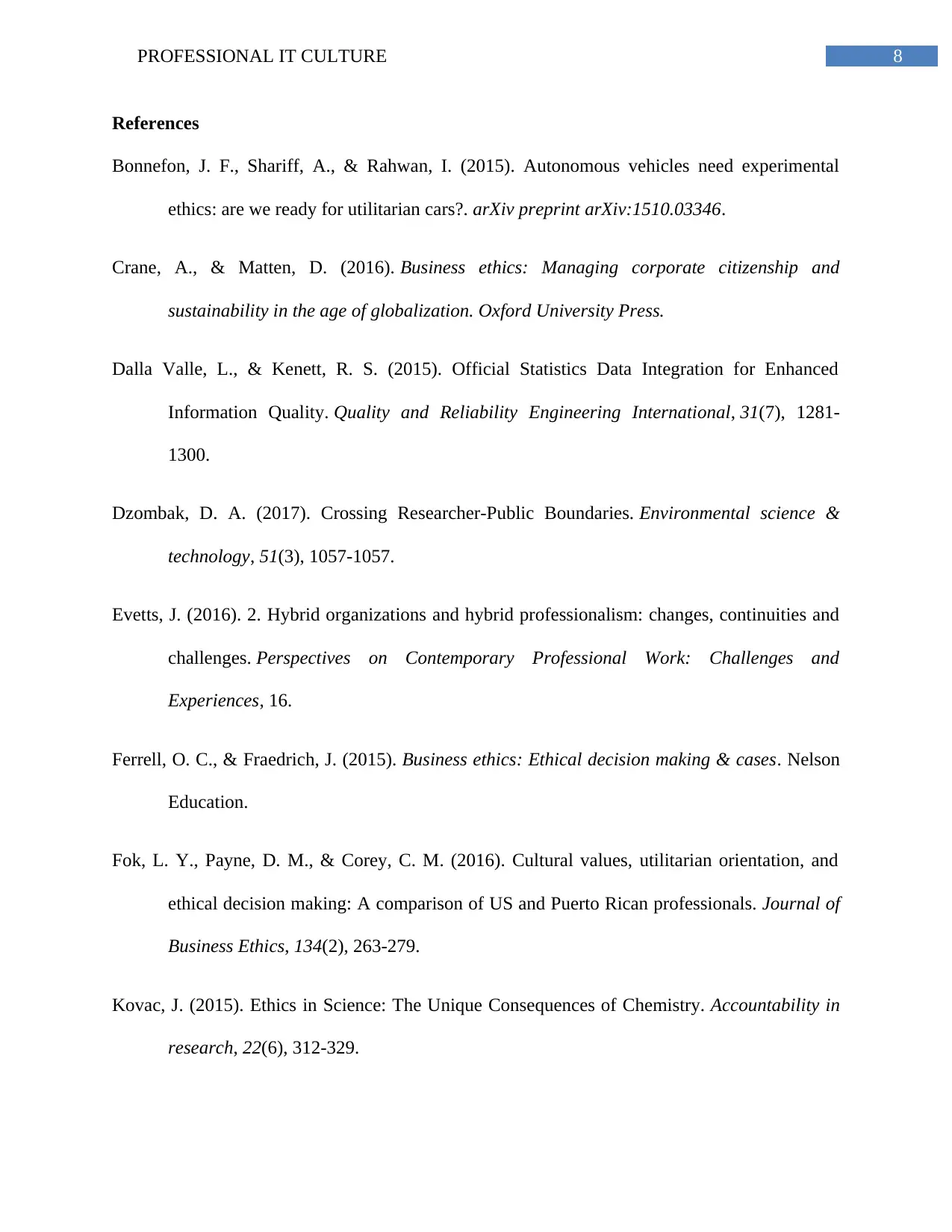
8PROFESSIONAL IT CULTURE
References
Bonnefon, J. F., Shariff, A., & Rahwan, I. (2015). Autonomous vehicles need experimental
ethics: are we ready for utilitarian cars?. arXiv preprint arXiv:1510.03346.
Crane, A., & Matten, D. (2016). Business ethics: Managing corporate citizenship and
sustainability in the age of globalization. Oxford University Press.
Dalla Valle, L., & Kenett, R. S. (2015). Official Statistics Data Integration for Enhanced
Information Quality. Quality and Reliability Engineering International, 31(7), 1281-
1300.
Dzombak, D. A. (2017). Crossing Researcher-Public Boundaries. Environmental science &
technology, 51(3), 1057-1057.
Evetts, J. (2016). 2. Hybrid organizations and hybrid professionalism: changes, continuities and
challenges. Perspectives on Contemporary Professional Work: Challenges and
Experiences, 16.
Ferrell, O. C., & Fraedrich, J. (2015). Business ethics: Ethical decision making & cases. Nelson
Education.
Fok, L. Y., Payne, D. M., & Corey, C. M. (2016). Cultural values, utilitarian orientation, and
ethical decision making: A comparison of US and Puerto Rican professionals. Journal of
Business Ethics, 134(2), 263-279.
Kovac, J. (2015). Ethics in Science: The Unique Consequences of Chemistry. Accountability in
research, 22(6), 312-329.
References
Bonnefon, J. F., Shariff, A., & Rahwan, I. (2015). Autonomous vehicles need experimental
ethics: are we ready for utilitarian cars?. arXiv preprint arXiv:1510.03346.
Crane, A., & Matten, D. (2016). Business ethics: Managing corporate citizenship and
sustainability in the age of globalization. Oxford University Press.
Dalla Valle, L., & Kenett, R. S. (2015). Official Statistics Data Integration for Enhanced
Information Quality. Quality and Reliability Engineering International, 31(7), 1281-
1300.
Dzombak, D. A. (2017). Crossing Researcher-Public Boundaries. Environmental science &
technology, 51(3), 1057-1057.
Evetts, J. (2016). 2. Hybrid organizations and hybrid professionalism: changes, continuities and
challenges. Perspectives on Contemporary Professional Work: Challenges and
Experiences, 16.
Ferrell, O. C., & Fraedrich, J. (2015). Business ethics: Ethical decision making & cases. Nelson
Education.
Fok, L. Y., Payne, D. M., & Corey, C. M. (2016). Cultural values, utilitarian orientation, and
ethical decision making: A comparison of US and Puerto Rican professionals. Journal of
Business Ethics, 134(2), 263-279.
Kovac, J. (2015). Ethics in Science: The Unique Consequences of Chemistry. Accountability in
research, 22(6), 312-329.
⊘ This is a preview!⊘
Do you want full access?
Subscribe today to unlock all pages.

Trusted by 1+ million students worldwide
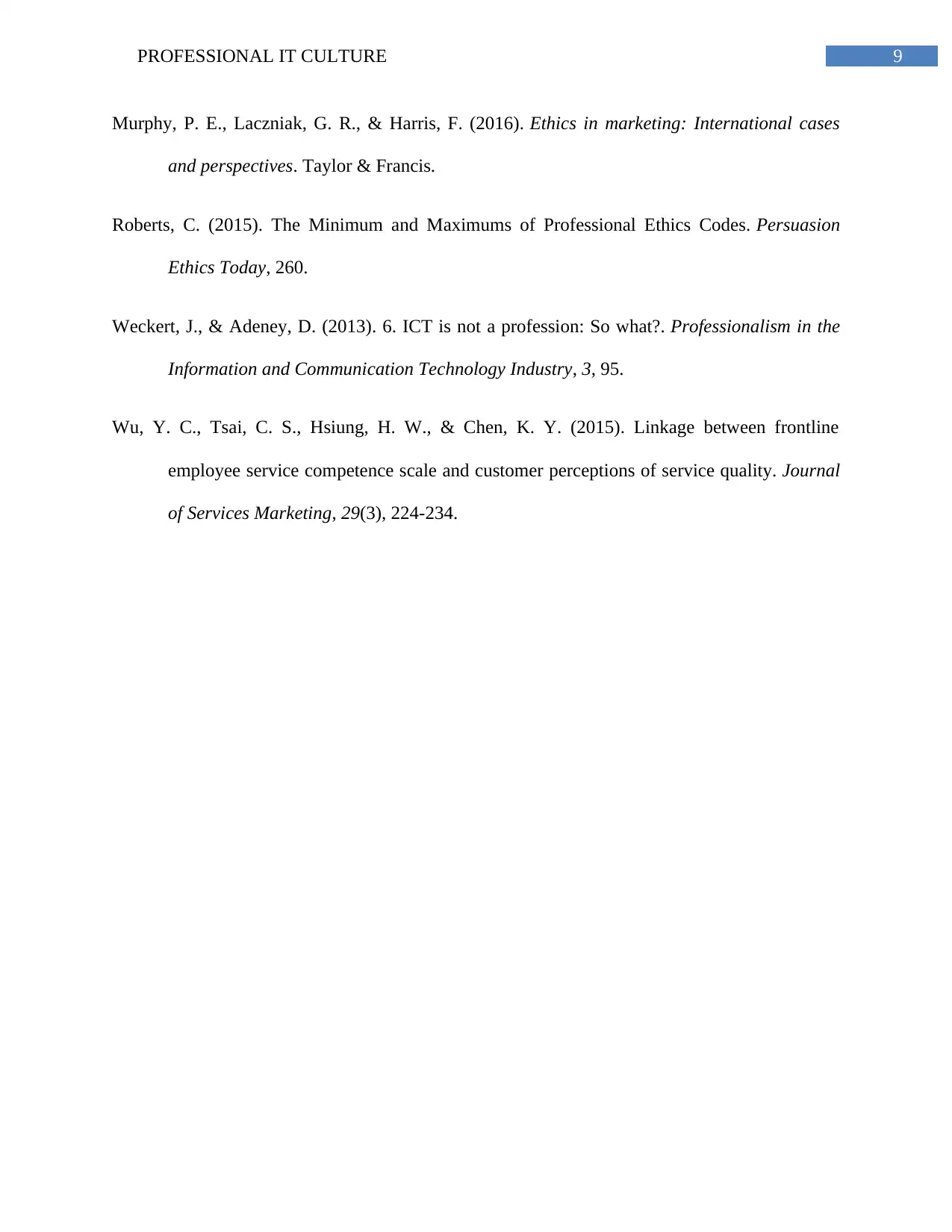
9PROFESSIONAL IT CULTURE
Murphy, P. E., Laczniak, G. R., & Harris, F. (2016). Ethics in marketing: International cases
and perspectives. Taylor & Francis.
Roberts, C. (2015). The Minimum and Maximums of Professional Ethics Codes. Persuasion
Ethics Today, 260.
Weckert, J., & Adeney, D. (2013). 6. ICT is not a profession: So what?. Professionalism in the
Information and Communication Technology Industry, 3, 95.
Wu, Y. C., Tsai, C. S., Hsiung, H. W., & Chen, K. Y. (2015). Linkage between frontline
employee service competence scale and customer perceptions of service quality. Journal
of Services Marketing, 29(3), 224-234.
Murphy, P. E., Laczniak, G. R., & Harris, F. (2016). Ethics in marketing: International cases
and perspectives. Taylor & Francis.
Roberts, C. (2015). The Minimum and Maximums of Professional Ethics Codes. Persuasion
Ethics Today, 260.
Weckert, J., & Adeney, D. (2013). 6. ICT is not a profession: So what?. Professionalism in the
Information and Communication Technology Industry, 3, 95.
Wu, Y. C., Tsai, C. S., Hsiung, H. W., & Chen, K. Y. (2015). Linkage between frontline
employee service competence scale and customer perceptions of service quality. Journal
of Services Marketing, 29(3), 224-234.
Paraphrase This Document
Need a fresh take? Get an instant paraphrase of this document with our AI Paraphraser
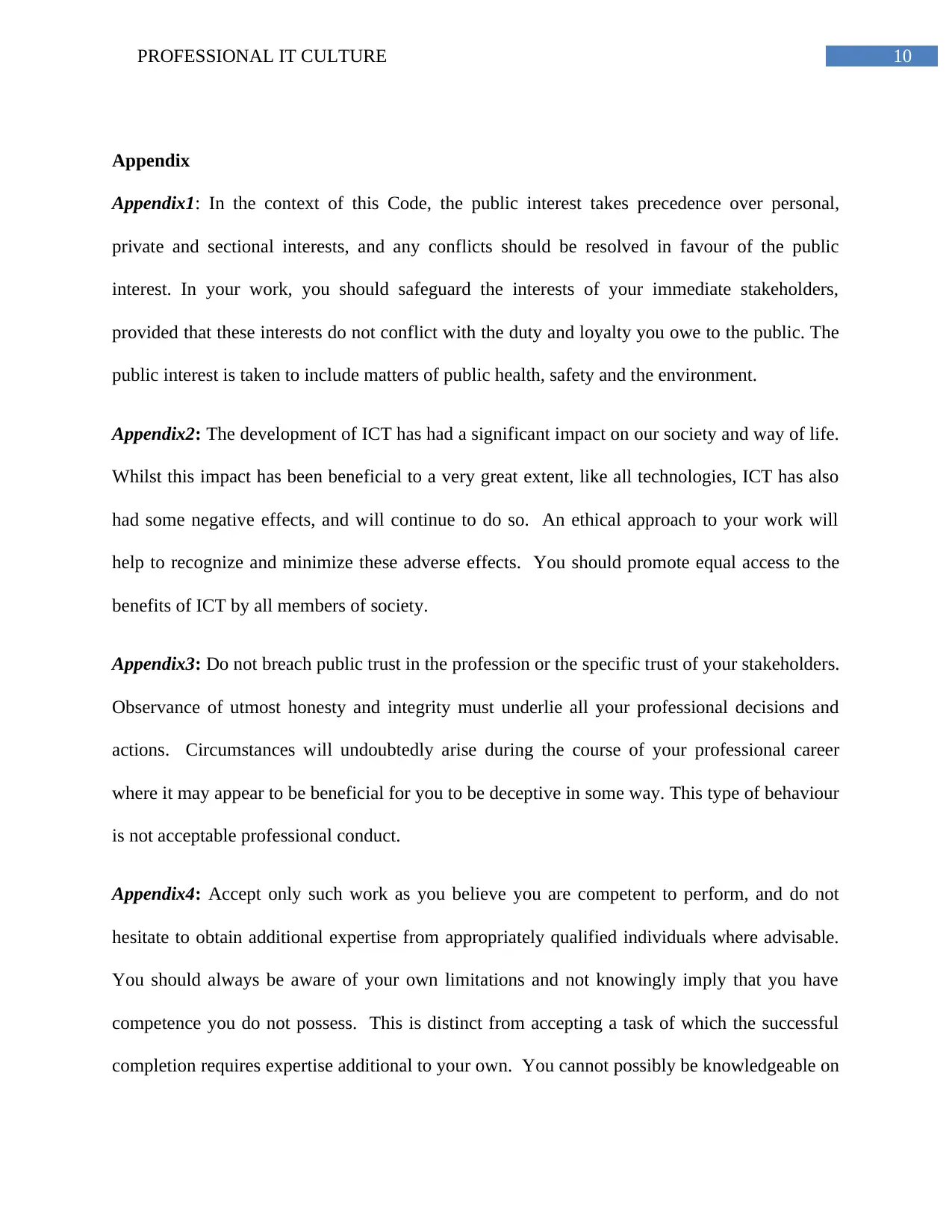
10PROFESSIONAL IT CULTURE
Appendix
Appendix1: In the context of this Code, the public interest takes precedence over personal,
private and sectional interests, and any conflicts should be resolved in favour of the public
interest. In your work, you should safeguard the interests of your immediate stakeholders,
provided that these interests do not conflict with the duty and loyalty you owe to the public. The
public interest is taken to include matters of public health, safety and the environment.
Appendix2: The development of ICT has had a significant impact on our society and way of life.
Whilst this impact has been beneficial to a very great extent, like all technologies, ICT has also
had some negative effects, and will continue to do so. An ethical approach to your work will
help to recognize and minimize these adverse effects. You should promote equal access to the
benefits of ICT by all members of society.
Appendix3: Do not breach public trust in the profession or the specific trust of your stakeholders.
Observance of utmost honesty and integrity must underlie all your professional decisions and
actions. Circumstances will undoubtedly arise during the course of your professional career
where it may appear to be beneficial for you to be deceptive in some way. This type of behaviour
is not acceptable professional conduct.
Appendix4: Accept only such work as you believe you are competent to perform, and do not
hesitate to obtain additional expertise from appropriately qualified individuals where advisable.
You should always be aware of your own limitations and not knowingly imply that you have
competence you do not possess. This is distinct from accepting a task of which the successful
completion requires expertise additional to your own. You cannot possibly be knowledgeable on
Appendix
Appendix1: In the context of this Code, the public interest takes precedence over personal,
private and sectional interests, and any conflicts should be resolved in favour of the public
interest. In your work, you should safeguard the interests of your immediate stakeholders,
provided that these interests do not conflict with the duty and loyalty you owe to the public. The
public interest is taken to include matters of public health, safety and the environment.
Appendix2: The development of ICT has had a significant impact on our society and way of life.
Whilst this impact has been beneficial to a very great extent, like all technologies, ICT has also
had some negative effects, and will continue to do so. An ethical approach to your work will
help to recognize and minimize these adverse effects. You should promote equal access to the
benefits of ICT by all members of society.
Appendix3: Do not breach public trust in the profession or the specific trust of your stakeholders.
Observance of utmost honesty and integrity must underlie all your professional decisions and
actions. Circumstances will undoubtedly arise during the course of your professional career
where it may appear to be beneficial for you to be deceptive in some way. This type of behaviour
is not acceptable professional conduct.
Appendix4: Accept only such work as you believe you are competent to perform, and do not
hesitate to obtain additional expertise from appropriately qualified individuals where advisable.
You should always be aware of your own limitations and not knowingly imply that you have
competence you do not possess. This is distinct from accepting a task of which the successful
completion requires expertise additional to your own. You cannot possibly be knowledgeable on
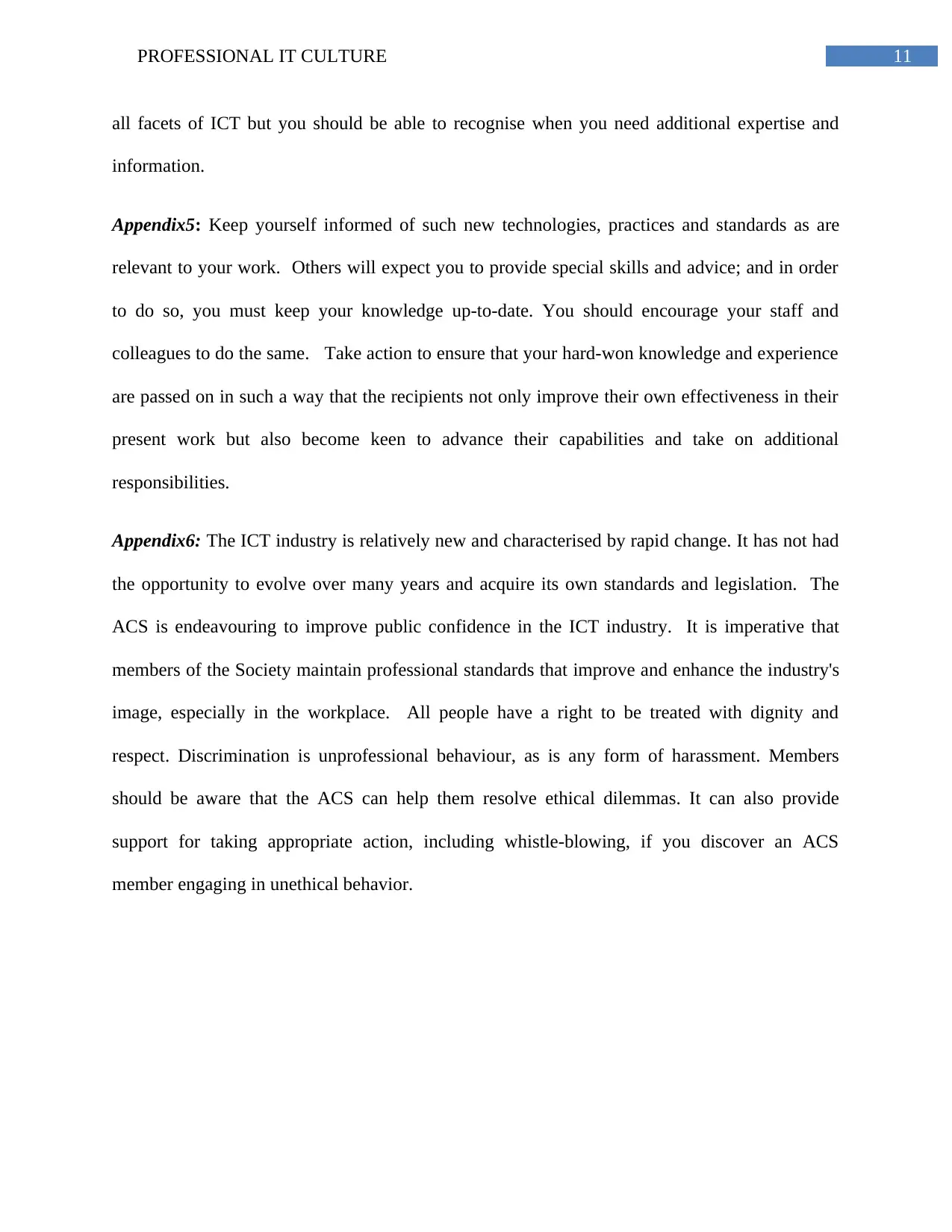
11PROFESSIONAL IT CULTURE
all facets of ICT but you should be able to recognise when you need additional expertise and
information.
Appendix5: Keep yourself informed of such new technologies, practices and standards as are
relevant to your work. Others will expect you to provide special skills and advice; and in order
to do so, you must keep your knowledge up-to-date. You should encourage your staff and
colleagues to do the same. Take action to ensure that your hard-won knowledge and experience
are passed on in such a way that the recipients not only improve their own effectiveness in their
present work but also become keen to advance their capabilities and take on additional
responsibilities.
Appendix6: The ICT industry is relatively new and characterised by rapid change. It has not had
the opportunity to evolve over many years and acquire its own standards and legislation. The
ACS is endeavouring to improve public confidence in the ICT industry. It is imperative that
members of the Society maintain professional standards that improve and enhance the industry's
image, especially in the workplace. All people have a right to be treated with dignity and
respect. Discrimination is unprofessional behaviour, as is any form of harassment. Members
should be aware that the ACS can help them resolve ethical dilemmas. It can also provide
support for taking appropriate action, including whistle-blowing, if you discover an ACS
member engaging in unethical behavior.
all facets of ICT but you should be able to recognise when you need additional expertise and
information.
Appendix5: Keep yourself informed of such new technologies, practices and standards as are
relevant to your work. Others will expect you to provide special skills and advice; and in order
to do so, you must keep your knowledge up-to-date. You should encourage your staff and
colleagues to do the same. Take action to ensure that your hard-won knowledge and experience
are passed on in such a way that the recipients not only improve their own effectiveness in their
present work but also become keen to advance their capabilities and take on additional
responsibilities.
Appendix6: The ICT industry is relatively new and characterised by rapid change. It has not had
the opportunity to evolve over many years and acquire its own standards and legislation. The
ACS is endeavouring to improve public confidence in the ICT industry. It is imperative that
members of the Society maintain professional standards that improve and enhance the industry's
image, especially in the workplace. All people have a right to be treated with dignity and
respect. Discrimination is unprofessional behaviour, as is any form of harassment. Members
should be aware that the ACS can help them resolve ethical dilemmas. It can also provide
support for taking appropriate action, including whistle-blowing, if you discover an ACS
member engaging in unethical behavior.
⊘ This is a preview!⊘
Do you want full access?
Subscribe today to unlock all pages.

Trusted by 1+ million students worldwide
1 out of 12
Your All-in-One AI-Powered Toolkit for Academic Success.
+13062052269
info@desklib.com
Available 24*7 on WhatsApp / Email
![[object Object]](/_next/static/media/star-bottom.7253800d.svg)
Unlock your academic potential
Copyright © 2020–2025 A2Z Services. All Rights Reserved. Developed and managed by ZUCOL.


